I would love to introduce you to some of our rowdiest residents at Wingham Wildlife Park. We have four goose species and you can usually hear them honking away on our large lake at the top of the Park. They are quite comical and will definitely be your best mate if you are standing by the pellet feeder by the Coati’s enclosure! They’ll happily gobble up any leftover pellets that you’ve purchased at the Park, but please don’t bring in your own food for our wildfowl as they are on a strictly controlled diet! If you’ve read any of my blogs before you may have realised I love to go birdwatching and recording in my spare time. Interestingly twelve species of geese have been recorded in the UK, and I’d like to talk about some of these wild geese a bit later on as well.
Greylag Geese and African Geese
As you can see (and hear!) from the video above our loudest geese are our female Greylag Goose Ross and male African Goose Waldo who have struck up a friendship. Greylag Geese (Anseranser) controversially are one of my favourite geese to see in the UK! This is because I love fluffy Goslings and they breed locally for me. Greylags are the largest of the wild geese native to the UK, but globally span across Europe, Central Asian Russia, Sri Lanka and Viet Nam. They are the UK’s only breeding goose and our most common.
Here in Kent Greylag Geese are an introduced population. This is the case for most of the Greylags in the UK apart from a small indigenous population of truly wild geese in Northwest Scotland and Western Isles, plus winter visitors which join us mainly from Iceland each year.
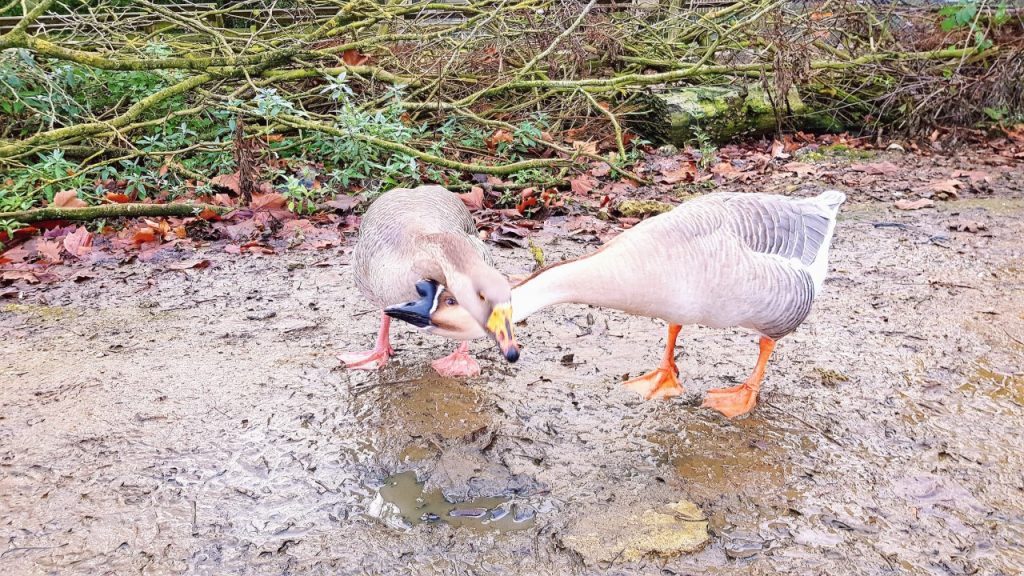
Waldo doesn’t often stray far from Ross as you can see in the photo above they love a cuddle with each other. African Geese (Anseranserdomesticus) are a breed of domestic goose which most likely originated in China, like the related Chinese Goose. It was first recognised as its own breed in 1874! Like most geese their diet consists of mainly seeds and grasses, but domesticated birds are mainly fed on commercially available bird feeds.
Red-breasted Geese
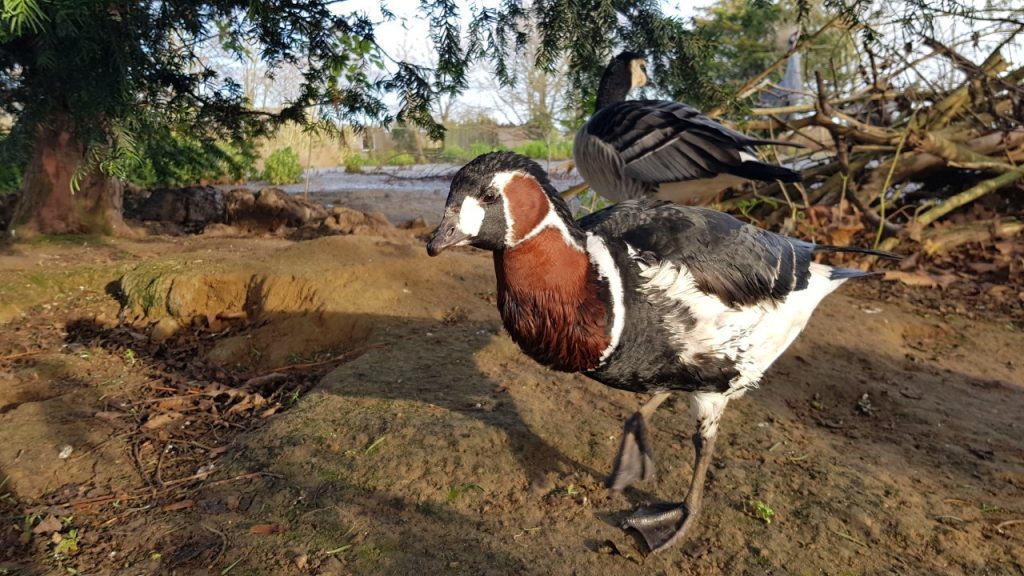
Our Red-Breasted Goose Kevin is our most attractive goose; I think they’re just stunning! Much smaller than its noisy roommates Red Breasted Geese (Brantaruficollis) can occasionally be found in the UK. They breed in Western Siberia and Northern Russia and spend the winter on the Black Sea lowlands of Azerbaijan Bulgaria, Greece, Romania and Ukraine. They are rare vagrants to the UK and other parts of Western Europe. A species which is now classed as Vulnerable on the IUCN red list as it has a fairly small population which appears to be declining quickly. Their decline is a bit of a mystery, but habitat loss could be an issue and mortality due to hunting could be very high. As with other Tundra species climate change is expected to have a negative impact on these beautiful geese.
Barnacle Geese
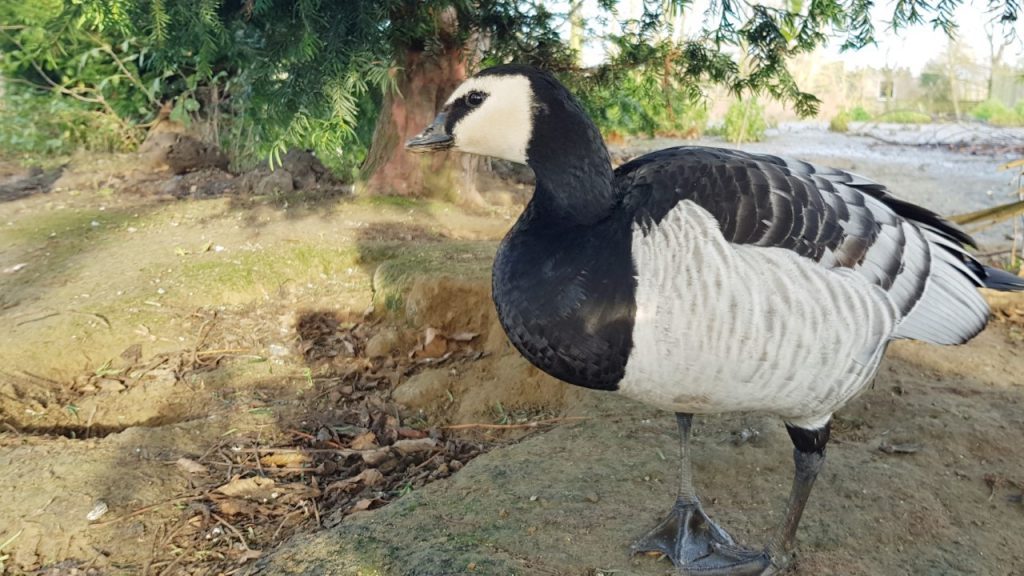
The last goose to introduce you to at the Park is our Barnacle Goose, Bill. Barnacle Geese (Branta leucopsis) are another species that breeds on the Arctic Tundra in Greenland, Spitsbergen and Russia. They come to the UK as winter visitors and their name derives from an old myth. They were once thought to have started life as Goose Barnacles growing on driftwood! Presumably because they were only seen in the winter and not on the nest… our knowledge of bird migration sure has come a long way!
Barnacle Geese are truly incredible. They breed on rocky cliffs, but of course there is no food here for a gosling, so shortly after they hatch the chicks jump plummeting to the ground to follow their parents to food and safety. Watch this drama here: (you will never look at our little Barnacle Goose in the same way again!).
Brent Geese.
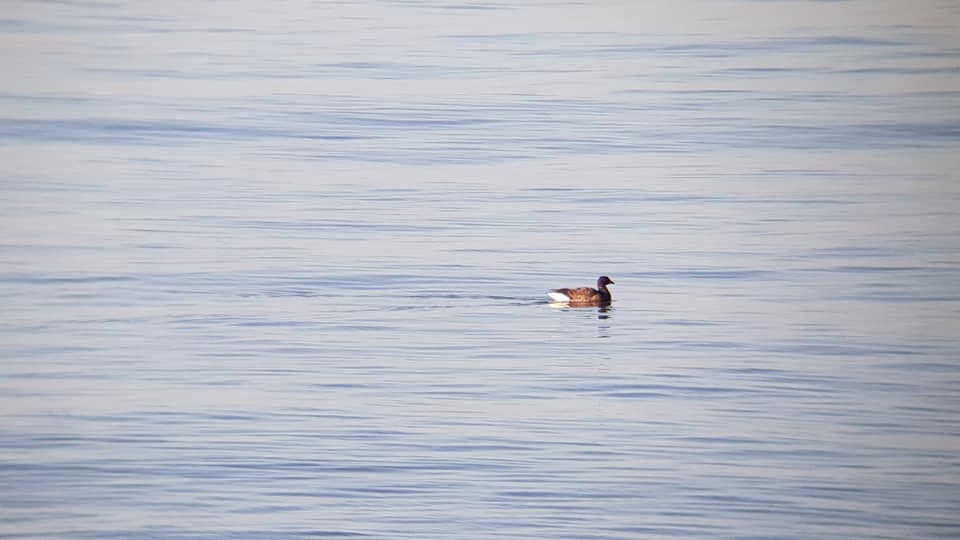
I wanted to feature the Geese at the park for my blog as the winter is a great time of year to see Geese here in the UK. Locally Kent has some fantastic nature reserves where you might be able to see geese. Stodmarsh (NNR), Sandwich and Pegwell Bay (NNR) and Oare Marshes Nature Reserves are my favourite places to visit. But you don’t need to visit a reserve to see geese! If you head to the coast you might be lucky enough to spot a Brent Goose. I often see them offshore or sometimes on the fields as I drive around the countryside. Brent Geese (Brantabernicla) are also winter visitors to the UK from Greenland, Spitsbergen, Northern Russia and North America.
Pink-footed Geese
You don’t have to travel too far to see wild Geese in the winter. Sandwich Bay Bird Observatory makes a great base for Kent Birders and as well as the resident population of Greylags on their Nature Reserve Restharrow Scrape, more interesting species turn up from time to time too. I walked from the Observatory to Worth to film these Pink-footed Geese (Anser brachyrhynchus). One of the UK’s smaller geese and one of my favourite species. I love them because when they fly their contact calls are unmistakeable as they shout “wink-wink” to each other. They also breed in Greenland, Iceland, Spitsbergen and spend the winter in North West Europe. We have around 510 thousand birds join us from these countries every winter.
Bean Geese
You may notice in the video above that one of the Geese at the back looks a bit different. I was very happy to find a Tundra Bean Goose in with this flock! There are two distinct populations of Been Goose (Anser fabilis) in the UK. It is argued whether these are separate subspecies but most authorities seem to agree that they are separate. The Tundra Bean Goose (A.f.rossicus) and the rarer Taiga Bean Goose (A.f.fabalis) which winters mainly in Stirlingshire, Scotland and Norfolk.
My absolute favourite place to see Geese in the UK is Norfolk. I think the best reserve to visit is Snettisham. It’s well worth putting in the effort to get there at dawn to watch these birds leave their overnight roosts in search of food. Apologies for the blurry video above (and my excited commentary!) as it was still quite dark, but hopefully you get a sense of the staggering amount of geese found on this reserve. No one really knows why skeins of geese fly in these characteristic V-shapes, but it is thought to have aerodynamic benefits. But again, the birds aren’t just confined to nature reserves. You only have to drive around for a little while before you find flocks of Pink-footed and White-fronted Geese.
White-fronted Geese
I think the White-fronted Goose (Anser albifrons) is quite pretty. Whilst they do resemble Greylags in appearance the adults have white around their bills and lovely black streaks and spots on their breast. Another Winter Visitor to the UK with around 14 thousand arriving from Greenland and Siberia. Interestingly the birds from Siberia have pink bills and Greenland birds have orange bills! In the UK they are a protected species and have a RED conservation status.
Canada Geese
Our Barnacle Goose is often confused with the much larger Canada Goose (Branta canadensis). These striking birds are the UK’s largest Goose but are actually an introduced species from North America. They were originally introduced to Britain in St. James Park, London around 300 years ago. Since then they have been very successful and now range across most of Britain with an estimated population of 62 thousand pairs! They are often considered pests as they form huge grazing flocks and can cause damage to crops.
Snow Geese
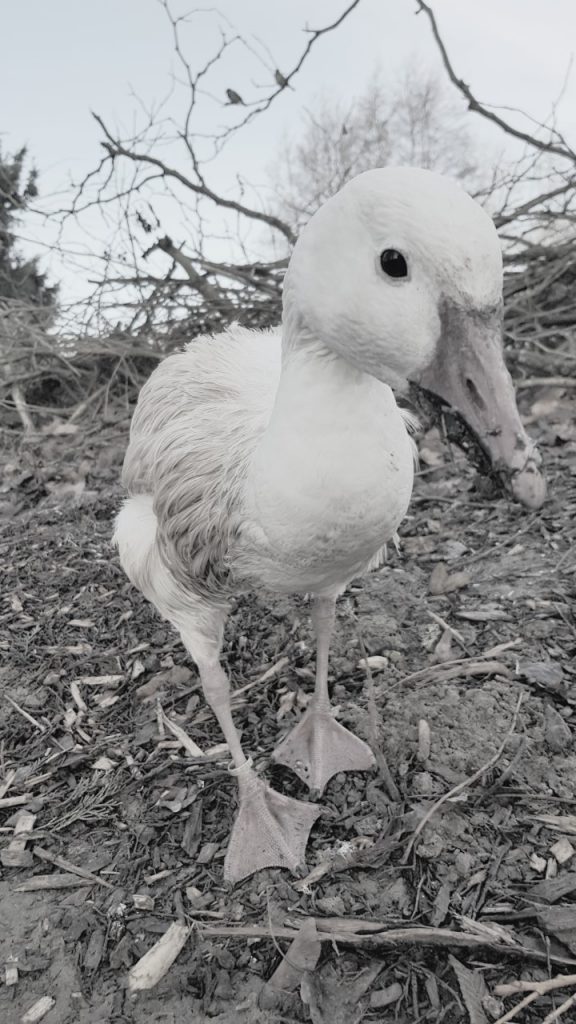
And finally, another Scarce Visitor to the UK is the Snow Goose (Chen caerulescens) which breed on Arctic Tundra in North America and North East Siberia. They usually spend the winter off the Coasts of North America, Japan and Eastern China, but around 75 birds join us here in the UK every year. Interestingly there are two colour morphs, a white morph and a darker blue morph! Although I think it looks more grey than blue. Other Goose species which have only been recorded a few times in the UK are Cackling Goose (Brantahutchinsii) and Lesser White-fronted Goose (Anser albifrons).
I hope I have inspired you to come and say hello to the Geese when you next visit the park and perhaps even to enjoy a nice fresh winter walk to find some of their wild relatives!


